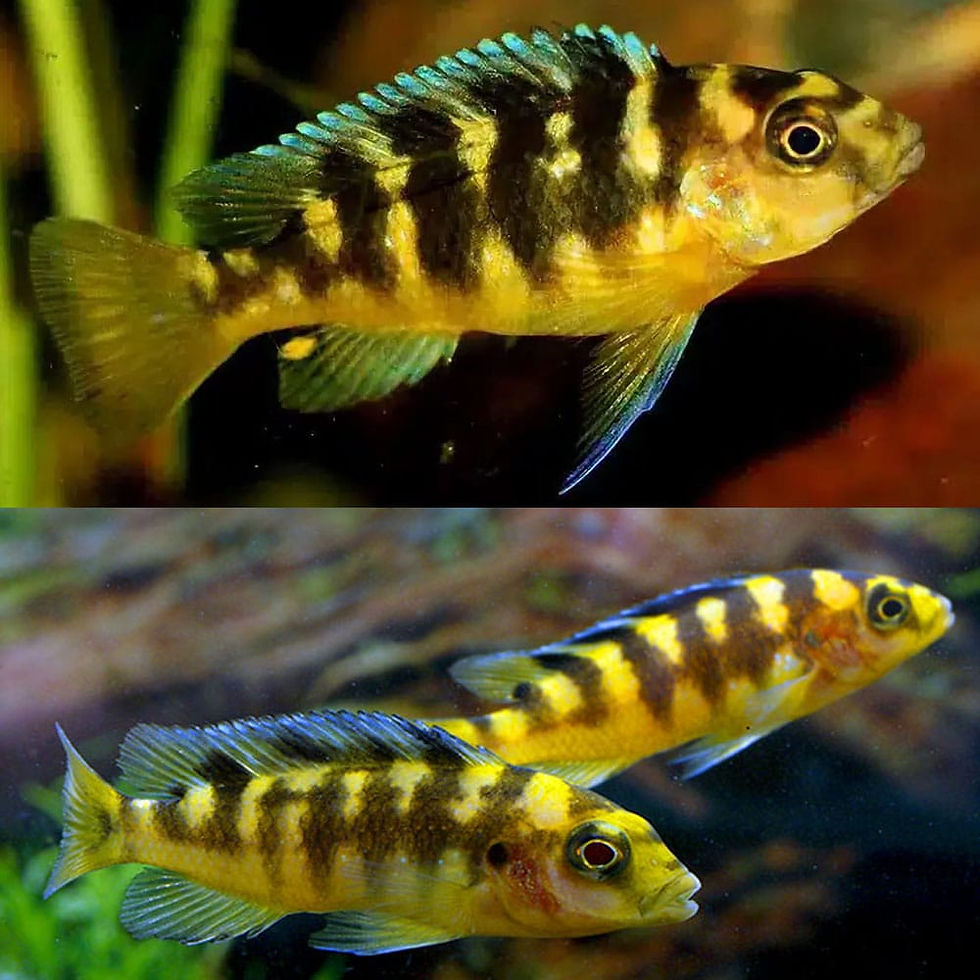Crabro Bumblebee Cichlid: A Bold and Dynamic Mbuna
The Crabro Bumblebee Cichlid (Pseudotropheus crabro), named for its striking black and yellow stripes, is a vibrant Mbuna species from Lake Malawi. Known for its bold appearance and active nature, this cichlid is a popular choice for experienced aquarists. Its fascinating behaviour and unique look make it a standout in African cichlid tanks.
Size and Lifespan
Crabro Bumblebee Cichlids grow to 12–15 cm, with males typically being larger and more vividly coloured than females. With proper care, they can live for 6–8 years, making them a long-term and dynamic addition to your aquarium.
Tank Size and Requirements
A tank of at least 250 liters is recommended for these active and territorial fish. They thrive in water temperatures of 24°C–28°C and a pH range of 7.8–8.6. Create a habitat with rocky caves and sandy substrates to mimic their Lake Malawi environment. The right tank setup reduces stress and helps manage their territorial nature.
Tank Mates
Crabro Bumblebee Cichlids are aggressive, particularly during breeding or when establishing dominance. They are best kept with other robust Mbuna species like Red Zebras, Yellow Labs, or Auratus Cichlids. Avoid housing them with timid or slow-moving fish. Keeping them in a group with a male-to-female ratio of 1:4 helps reduce aggression.
Feeding Crabro Bumblebee Cichlids
These omnivorous cichlids thrive on a mixed diet. Offer high-quality cichlid pellets or flakes formulated for Mbuna. Supplement with occasional live or frozen foods like brine shrimp or krill. To prevent digestive issues, avoid excessive protein and include vegetable-based foods like spirulina flakes or blanched spinach. A balanced diet keeps them healthy and enhances their striking colours.
Breeding Crabro Bumblebee Cichlids
Breeding is straightforward in a well-maintained tank. Males establish territories and court females with vibrant displays. Females are maternal mouthbrooders, carrying fertilized eggs for 18–25 days before releasing fry. Provide multiple hiding spots and spawning sites, such as flat rocks or caves, to encourage natural breeding behaviour. Fry can be raised on finely crushed flakes or baby brine shrimp.
FAQs
How big do Crabro Bumblebee Cichlids get?
They grow to 12–15 cm, with males being larger and more colourful.Are they aggressive?
Yes, they are highly aggressive and best kept with other robust Mbuna species.What tank mates are suitable?
Yellow Labs, Red Zebras, and Auratus Cichlids are excellent companions.What do they eat?
They thrive on cichlid pellets, occasional live or frozen foods, and vegetable-based options like spirulina flakes.How do you breed them?
They are maternal mouthbrooders. Males court females, and fry are released after 18–25 days of incubation.Are Crabro Bumblebee Cichlids aggressive?
They’re moderately aggressive mbuna that need appropriate tank mates and setup.What do Crabro Cichlids eat?
They’re omnivorous with herbivorous tendencies, eating mbuna pellets and vegetables.Can Crabro Cichlids live with other African cichlids?
Yes, they work well with other mbuna of similar size and temperament.What water conditions do Crabro Cichlids need?
Hard, alkaline water with pH 7.8-8.6 and temperature 24-28°C.Species Overview
- Species: Pseudotropheus crabro
- Common Name: Crabro Bumblebee Cichlid
- Origin: Lake Malawi, Africa
- Diet: Omnivore
- PH Range: 7.8–8.6
- Temperature: 24°C–28°C
- Max Size: Up to 15 cm
- Tank Size: Minimum 250 liters
Mbuna Cichlid Care Guide
Tank Requirements:
- Tank size: Minimum 200 litres, 300+ litres preferred
- Temperature: 24-28°C
- pH: 7.8-8.6, hard alkaline water
- Decorations: Lots of rocks, caves, cichlid sand
- Territoriality: Multiple caves to establish territories
Feeding Guide:
- Diet: Omnivorous with herbivorous lean
- Feeding schedule: 2-3 small meals daily
- Primary foods: High-quality mbuna pellets, spirulina
- Vegetables: Blanched peas, algae wafers
- Avoid: Excessive protein (can cause bloat)
Behavior & Aggression:
- Temperament: Moderately aggressive mbuna
- Social structure: Best in groups with multiple females per male
- Territory: Defends cave areas
- Activity: Active swimmer, constantly grazing
Tank Mate Compatibility:
- Compatible with: Other mbuna of similar size and temperament
- Avoid: Peaceful sh, much smaller or larger mbuna
- Best setup: Mixed mbuna community with proper ratios
- Overstocking: Slight overstocking can reduce aggression





